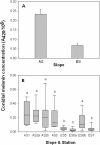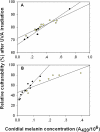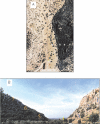Adaptive melanin response of the soil fungus Aspergillus niger to UV radiation stress at "Evolution Canyon", Mount Carmel, Israel
- PMID: 18714346
- PMCID: PMC2500164
- DOI: 10.1371/journal.pone.0002993
Adaptive melanin response of the soil fungus Aspergillus niger to UV radiation stress at "Evolution Canyon", Mount Carmel, Israel
Abstract
Background: Adaptation is an evolutionary process in which traits in a population are tailored by natural selection to better meet the challenges presented by the local environment. The major discussion relating to natural selection concerns the portraying of the cause and effect relationship between a presumably adaptive trait and selection agents generating it. Therefore, it is necessary to identify trait(s) that evolve in direct response to selection, enhancing the organism's fitness. "Evolution Canyon" (EC) in Israel mirrors a microcosmic evolutionary system across life and is ideal to study natural selection and local adaptation under sharply, microclimatically divergent environments. The south-facing, tropical, sunny and xeric "African" slope (AS) receives 200%-800% higher solar radiation than the north-facing, temperate, shady and mesic "European" slope (ES), 200 meters apart. Thus, solar ultraviolet radiation (UVR) is a major selection agent in EC influencing the organism-environment interaction. Melanin is a trait postulated to have evolved for UV-screening in microorganisms. Here we investigate the cause and effect relationship between differential UVR on the opposing slopes of EC and the conidial melanin concentration of the filamentous soil fungus Aspergillus niger. We test the working hypothesis that the AS strains exhibit higher melanin content than strains from the ES resulting in higher UV resistance.
Methodology/principal findings: We measured conidial melanin concentration of 80 strains from the EC using a spectrophotometer. The results indicated that mean conidial melanin concentration of AS strains were threefold higher than ES strains and the former resisted UVA irradiation better than the latter. Comparisons of melanin in the conidia of A. niger strains from sunny and shady microniches on the predominantly sunny AS and predominantly shady ES indicated that shady conditions on the AS have no influence on the selection on melanin; in contrast, the sunny strains from the ES displayed higher melanin concentrations.
Conclusions/significance: We conclude that melanin in A. niger is an adaptive trait against UVR generated by natural selection.
Conflict of interest statement
Figures




References
-
- Williams GC. Adaptation and natural selection. Princeton: Princeton University Press; 1966.
-
- Darwin C. On the origin of species by means of natural selection. London: John Murray; 1859. p. 502.
-
- Rainey PB, Travisano M. Adaptive radiation in a heterogeneous environment. Nature. 1998;392:69–72. - PubMed
-
- Nevo E. Asian, African and European biota meet at “Evolution Canyon” Israel: local tests of global biodiversity and genetic diversity patterns. Proc Roy Soc Lond B. 1995;262:149–155.
-
- Nevo E. Evolution in action across phylogeny caused by microclimatic stresses at “Evolution Canyon”. Theor Pop Biol. 1997;52:231–243. - PubMed
Publication types
MeSH terms
Substances
LinkOut - more resources
Full Text Sources
Research Materials

